Shashlyk po-karski (Kars-style shashlyk) is a rather mysterious dish. Every time I’ve ordered it in restaurants, I’ve been served either a rack of lamb or individual grilled lamb chops. What made either version specifically from Kars, a Turkish town that once belonged to medieval Armenia? Why not call it chalakhach, another dish of mysterious origins that seems to consist of grilled lamb chops?
Pokhlebkin sheds some light and gives a pretty different definition of the dish — and unlike Brighton Beach restaurant owners, he was a food historian. In his essential Cookbook of the Soviet Peoples, he explains what distinguishes a shashlyk po-karski from other kebabs:
- The dish requires round chunks of lamb loin of similar shapes, each weighing about half a pound.
- The marinade is different from what you use in Georgian mtsvadi (Georgian kebabs tend to be minimally marinated).
- The shashlyk is cooked progressively, and thin pieces are cut off the outside while the rest keeps grilling.
This still doesn’t explain why Kars Armenians decided all of a sudden to invent this Turkish-sounding dish, but I think I have a theory.
You may have noticed that the above description is strongly reminiscent of both Döner kebabs and Gyro (depending whether you choose to side with the Turks or the Greeks). In fact, the vertical spit used to grill these meats is a relatively recent invention, dating from the 19th century. The horizontal version of the dish, which is much older, shares ancestors with the Cağ kebabı found in the Turkish province of Erzurum. Since Erzurum is only slightly more than 100 miles away from Kars, can we reasonably assume that this is where Armenians took inspiration for what became known as shashlyk po-karski?
Whether you choose to call it shashlyk po-karski, Döner kebab, or gyro, this is not a dish that you would typically consider making at home. There have been some attempts, though, such as Alton Brown’s Gyro Meat with Tzatziki Sauce. The sheer number of inaccuracies this guy can pack in a few minutes really is shocking:
- Gyro is not normally made of ground lamb. The industrial crap is made from ground lamb. It’s a little bit like claiming that hamburgers must be made from pink slime.
- “We’re after a tight, slightly dried texture”. Does this sound appealing to you? I’m after a very moist texture; the meat’s natural texture, in fact.
- Is he really cooking this poor little lamb to 175 F??? What did it ever do to Alton to deserve such a punishment? Unless you work for the USDA, meat is well-done at 160 F.
- In a real gyro, once you’ve cut off all the grilled outer layer, you wait until the meat has grilled some more before cutting again. But apparently Alton’s going for the trashy 4-AM-on-Houston-Street version.
- And it only gets worse… There’s a monstrosity baked in a cake pan. There’s the electric knife, a tool favored by people who don’t know how to sharpen/use a knife. And there’s an extra serving of Alton’s decidedly unfunny humor, possibly to prevent viewers from thinking about what’s really cooking, and realizing the guy’s making glorified dog food with expensive and supernumerary pieces of equipment.
So yes, there are versions out there of what you should not be doing. In fact, the Guardian’s Tim Hayward does even a little bit worse. Let’s see if we can do a little bit better (spoiler: we can):
- While I’ve seen recipes using the loin or the leg, I chose to use a rack of lamb. The rack contains the perfect fat-to-meat ratio, and it’s just big enough that you can make something that follows the principle of a Döner, but without having to invite the whole neighborhood to finish the leftovers. It also happens to be my favorite cut of lamb.
- My marinade is a mix of Armenian (brandy, wine) and Turkish (Urfa pepper) influences, with a good dose of Food Perestroika’s favorites (star anise, transglutaminase). It’s definitely influenced by Pokhlebkin’s version, but it’s ultimately quite different in the end. Some recipes add herbs such as basil. Feel free to try that, but I feel like it might make more sense to add fresh herbs into the sandwich once the meat is cooked.
- Which brings us to the bread question. Pita, lavash, and baguette are all fine. Lavash certainly adds a more Caucasian note. (If you’re brave enough to man the grill and bake bread at the same time, I have a recipe here.)
- Finally, the garnishes. This is really a question of personal taste. Back when I was a student in Paris, I remember eating gyros with onion, tomato, and tastsika on rue de la Huchette, shawarma with fallafel on rue des Rosiers, and Döner kebabs with fried eggplant near Beaubourg. In my Azerbaijan adventures, I showed a café in Quba where you could request tomatoes, onions, cucumbers, chopped herbs, and hot sauce. My preference these days tends towards some kind of eggplant caviar, and I give a recipe below, very loosely adapted from Jabir Khalifazadeh’s The Gifts of Azerbaijan National Cusine’s Feast.
The proportions below make about three wraps, depending on their size, and you can count one and a half wraps per person to make a meal. Ideally, you would make at least two shashlyks (doubling the proportions), and have two people work on the preparation. This way, one person can grill the shashlyks while the other one cuts and assembles them, and you can have two wraps ready at almost the same time.
Marinated lamb
Yields about 3 servings
1 whole rack of lamb (about 800 g with bone, 580 g without bone)
1% (about 5.8 g) salt
0.5% (about 2.9 g) transglutaminase (optional)
0.6 g ground coriander
0.4 g ground star anise
0.9 g Urfa pepper
15 g red wine
8 g Armenian brandy
35 g peeled onion
- Remove the bones from the rack of lamb. Cut the rack into 3 even pieces.
- Slice each piece open part way, across the thickness, and unfold it like a wallet — this is easier to understand when you look at the picture.
- You should have 3 pieces, each about 17 cm long, 8.5 cm wide, and 2 cm thick. Cut each piece in half — you now have 6 squares of similar size.
- In a small bowl, mix the salt, transglutaminase, coriander, star anise, pepper, wine, and brandy. The transglutaminase is optional; it just helps the pieces of meat stick together. Chop the onion very finely, and mix into the bowl. Spread this marinade over each piece of meat, then stack the pieces together.
- Place the meat into a sous-vide pouch, add any left over marinade, and vacuum-seal. Refrigerate overnight.
- Cook the lamb in its pouch in a 57.5 C / 136 F water bath for 3 hours. Let cool in a bath of cold water, and reserve. This step is somewhat optional, but it greatly reduces the time it takes to grill the meat, as well as the wait before each serving of meat is ready to eat.
Eggplant caviar
Yields about 3 servings
260 g baby eggplant
70 g onion
40 g olive oil
120 g peeled and seeded tomato, small dice
3.5 g salt
0.75 g Urfa pepper
- Wrap the whole, unpeeled eggplants in foil, and bake in a 200 C / 400 F oven for 1 hour, until tender. Let cool, then scoop out the flesh, and reserve.
- Thinly slice the onion with a mandoline.
- In a saucepan over medium heat, sauté the onion with half of the oil for 10 minutes.
- Add the eggplant flesh, tomato, salt, pepper, and the rest of the oil. Cover and cook over low heat for 30 minutes.
- Remove the lid, turn the heat to high, and cook 5 more minutes, stirring constantly. Let cool and reserve.
Cooking the shashlyk and assembling
Yields about 3 servings
marinated lamb
3 pieces lavash, about 20 cm x 30 cm
eggplant caviar
- Take the marinated lamb out of the sous-vide pouch, and place on three parallel wide, flat skewers. This amount of meat needs a lot of support to remain shaped into a compact block while cooking, but we will remove the two outer skewers once we start cutting pieces off.
- Prepare a wood fire on your mangal (see explanations here). Once all the flames have died, place the shashlyk on the grill. Turn the skewers frequently, whenever the meat gains a shade of brown. As you can see below, the beauty of the wide skewers is that you can turn them 90 degrees and still have a stable position.
- If the grease re-ignites the flames, move the shashlyk to a different area of the mangal, or let it rest on a tray for a minute. Once all the sides are nicely browned, you’re ready to cut a first round!
- Take the shashlyk out of the heat, and cut thin slices using a serrated knife. Holding the skewers vertically while cutting may look cool, but it’s much easier to just put them down on a cutting board, especially once there’s very little meat left. If the meat’s not cooked to your liking, it’s easy to put it back for a couple minutes — I think medium to medium-well is perfect for a po-karski.
- Place a piece of lavash on a board, then arrange the meat in the middle. Top with eggplant caviar (or whatever garnish you fancy), and roll into a wrap. One done!
- Return the shashlyk to the mangal. Just before doing so, you can gather the coals together to get more heat. Also, you can remove the outer skewers if they’re not holding meat anymore.
- Repeat until you’re done!
- One last piece of grilling advice: if you haven’t cooked the lamb sous-vide first, since the kebab takes a while to cook, if you’re afraid of running out of hot coals you can use half of your mangal for grilling, and the other half to make more coals (the fire below was made with birch logs).

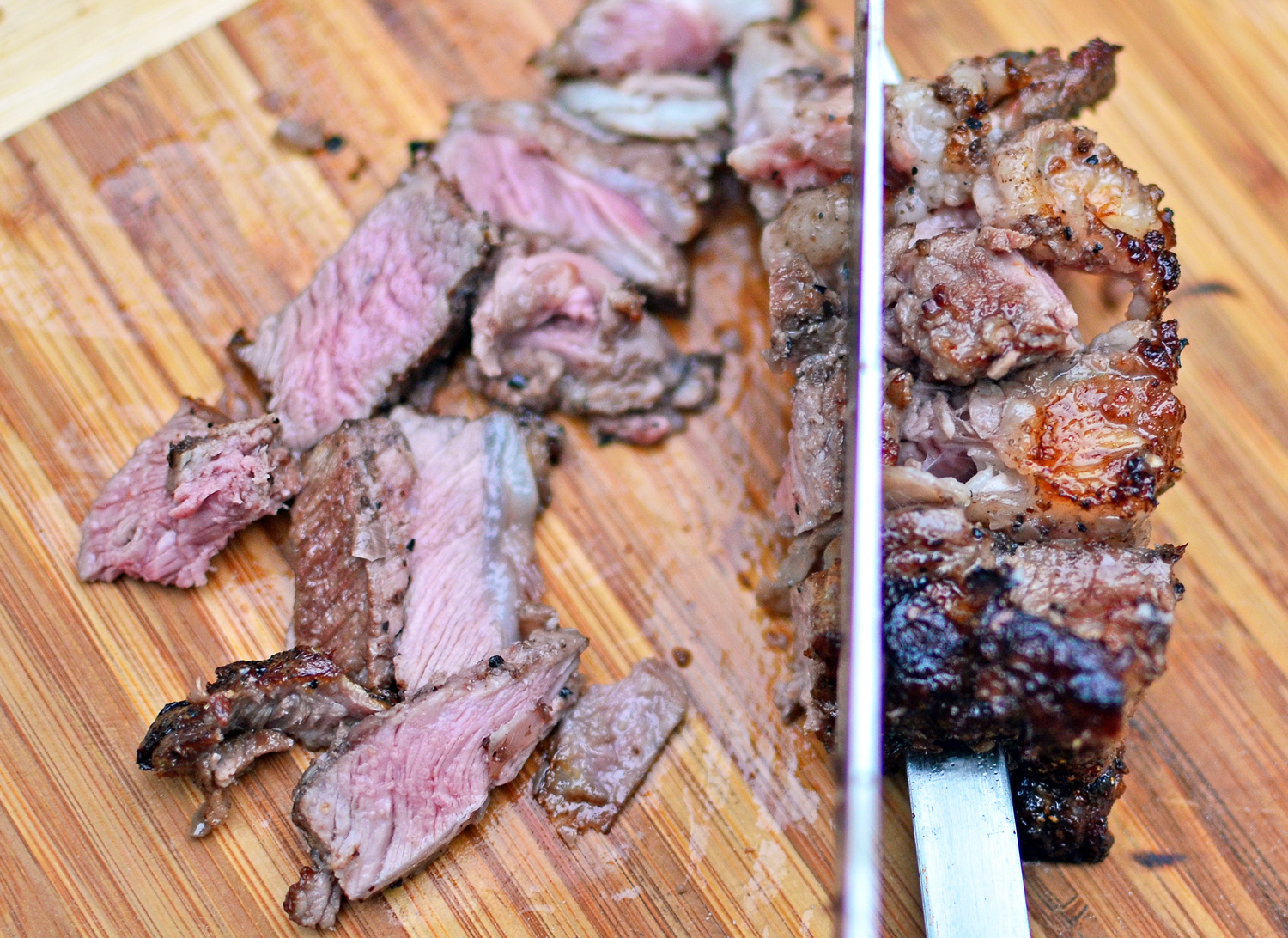
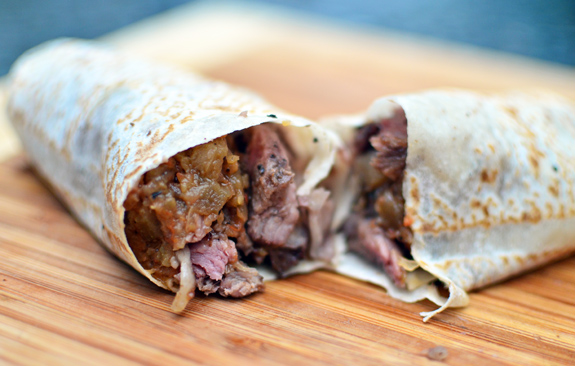


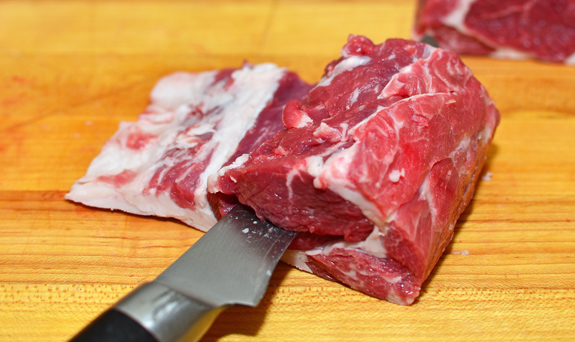

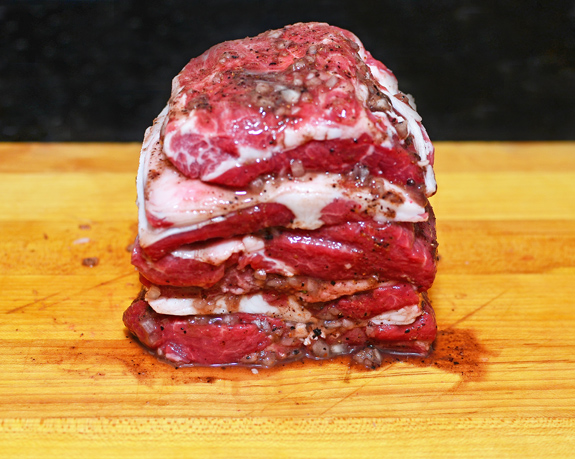
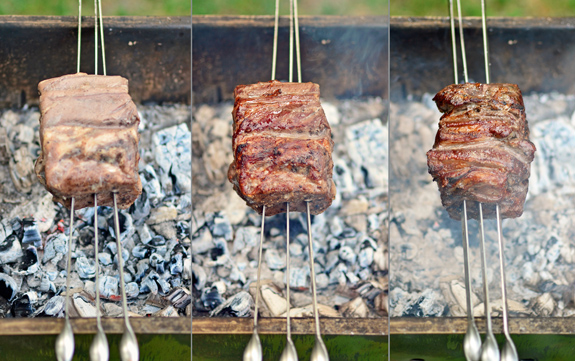
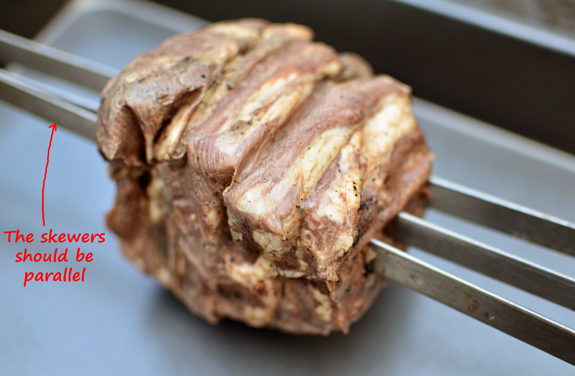

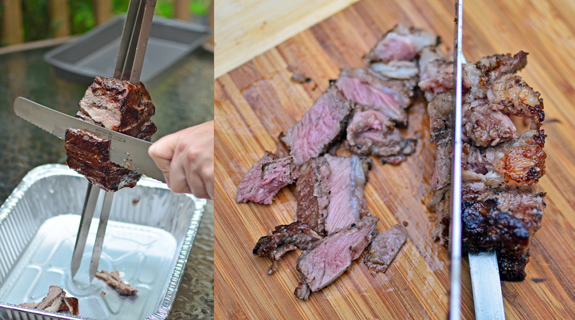

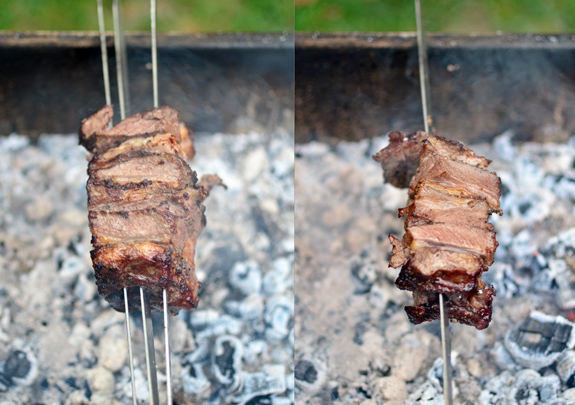

7 comments
The Georgian street-food version is called shwarma/shuarma (შუარმა) adding another level confusion to the mix. The mystery meat is maybe chicken (at halal places)? Or pork? (I haven’t eaten it in over a year, but my friends speculate…)
You have great pictures. Everything looks so scrumptious.
Thanks, LFFL!
[…] Lavash-wrapped kebabs in Baku (source : Food Perestroika) […]
Diese seite gefällt mir , auch gute Fotos
Schnippelboy
Danke, Schnippelboy!
Schön das Gericht erklärt, aber warum die Geschichte verzerren? Aus Kara wurden vor 100 Jahre die Armenier vertrieben, genau aus Ezrum auch. Davor waren es armenische Städte über tausende Jahre (ungewöhnlich für Nordeuropäer 😉).
Ich kann es nicht sagen, wem das Gericht gehört, aber Schaschlik ist nun mal in Armenien ein Nationalgericht.